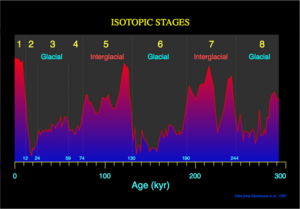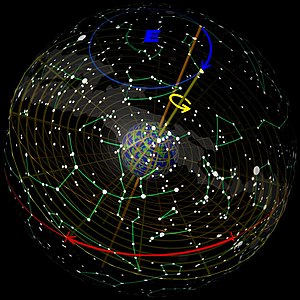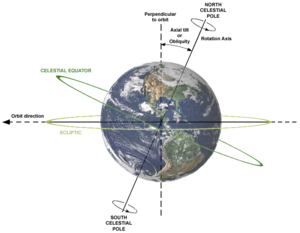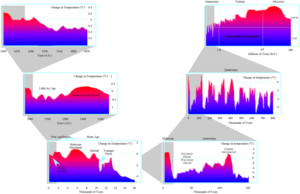Milankovitch cycles: Difference between revisions
imported>Chris Day (Actually this might be better up top wrt to the ice age cycles) |
imported>Corinne Sober mNo edit summary |
||
| Line 6: | Line 6: | ||
== Main Orbital Forces == | == Main Orbital Forces == | ||
[[Image:Outside view of precession.jpg|right|thumb|300px|{{#ifexist:Template:Outside view of precession.jpg/credit|{{Outside view of precession.jpg/credit}}<br/>|}}The blue circle is Earth's precession.]] | [[Image:Outside view of precession.jpg|right|thumb|300px|{{#ifexist:Template:Outside view of precession.jpg/credit|{{Outside view of precession.jpg/credit}}<br/>|}}The blue circle is Earth's precession.]] | ||
* '''Precession''' is Earth's wobble caused by our daily rotation while orbiting the Sun. It is the same physics as a top's wobble: the Earth's axis currently points towards the star [[Polaris]], but after | * '''Precession''' is Earth's wobble caused by our daily rotation while orbiting the Sun. Hipparchus discovered the equinoxes were not static, but move west on the ecliptic when compared to distant stars that relatively seem fixed at this distance. He lived some 100-200 years BC. | ||
It is the same physics as a top's wobble: the Earth's axis currently points towards the star [[Polaris]], but after 25,765 years [[Platonic year]] our axis will have made a complete circle. | |||
At | At approximately 12,882.5 years our North will be 180 degrees away from where it points now, essentially South from the current perspective. The study of paleomagnetism has demonstrated that the Earth's magnetic field varies in both orientation and intensity through time. The positions of magnetic north and magnetic south become interchanged. "Evidence from high-sedimentation-rate South Atlantic deep-sea cores indicates that global and Southern Ocean carbon budget shifts preceded thermohaline circulation changes during the last ice age initiation and termination and that these were preceded by ice-sheet growth and retreat, respectively." <ref>Alexander M. Piotrowski, Steven L. Goldstein, Sidney R. Hemming, and Richard G. Fairbanks Science 25 March 2005 307: 1933-1938 [DOI: 10.1126/science.1104883] </ref> [[Magnetochronology]] is the study of geomagnetic reversals. When you make an observation of the direction of the geometric field, to calculate the pole position, and this is done from only one location, then it is called a VGP. Ten or more site-mean VGPs should be used to calculate a paleomagnetic pole, this number would provide a reasonable average.<ref>http://faculty.up.edu/butler/books/chap07.pdf</ref> "The last swing of the [[VGP]] (virtual geomagnetic pole) from the southern hemisphere to the northern hemisphere in the Brunhes-Matuyama geomagnetic reversal." <ref>Okada, M., Niitsuma, N., " Detailed paleomagnetic records during the Brunhes-Matuyama geomagnetic reversal, and a direct determination of depth lag for magnetization in marine sediments" Physics of the Earth and Planetary Interiors, Volume 56, Issue 1-2, p. 133-150. 1989.</ref> Ocean sediments are used for [[chronostratigraphy]] as well. This is time related to layers of rock, in this case ocean sediments. The oxygen isotopes from the rocks can be analyzed and correlated to the present temperature of Earth. | ||
[[Image:AxialTiltObliquity.png|right|thumb|300px|{{#ifexist:Template:AxialTiltObliquity.png/credit|{{AxialTiltObliquity.png/credit}}<br/>|}}Earth's axis has a 23.5 degree tilt, pointing to Polaris]] | [[Image:AxialTiltObliquity.png|right|thumb|300px|{{#ifexist:Template:AxialTiltObliquity.png/credit|{{AxialTiltObliquity.png/credit}}<br/>|}}Earth's axis has a 23.5 degree tilt, pointing to Polaris]] | ||
Differential gravity is acting on Earth at all times. The Sun, moon, and other planets in our solar system all have a force of attraction. The equilateral bulge is proof of this, along with the precession of Earth's rotational axis. | |||
*'''Eccentricity'''is the measure of how much the orbit shape deviates from a circle. The eccentricity of the Earth's orbit is currently about 0.0167. A circular orbit: e=0 so earth is not far from a circle being only .016 more eccentric. | *'''Eccentricity'''is the measure of how much the orbit shape deviates from a circle. The eccentricity of the Earth's orbit is currently about 0.0167. A circular orbit: e=0 so earth is not far from a circle being only .016 more eccentric. | ||
Revision as of 13:32, 8 April 2008
Milankovitch cycles are cycles in the Earth's orbit that effect the amount of solar radiation striking the Earth at different times of the year. They are named after Milutin Milanković. These cycles include the precession, eccentricity, and obliquity of Earth's motions. All three processes occurring simultaneously produce 100,000 year ice age cycles.
Main Orbital Forces
- Precession is Earth's wobble caused by our daily rotation while orbiting the Sun. Hipparchus discovered the equinoxes were not static, but move west on the ecliptic when compared to distant stars that relatively seem fixed at this distance. He lived some 100-200 years BC.
It is the same physics as a top's wobble: the Earth's axis currently points towards the star Polaris, but after 25,765 years Platonic year our axis will have made a complete circle. At approximately 12,882.5 years our North will be 180 degrees away from where it points now, essentially South from the current perspective. The study of paleomagnetism has demonstrated that the Earth's magnetic field varies in both orientation and intensity through time. The positions of magnetic north and magnetic south become interchanged. "Evidence from high-sedimentation-rate South Atlantic deep-sea cores indicates that global and Southern Ocean carbon budget shifts preceded thermohaline circulation changes during the last ice age initiation and termination and that these were preceded by ice-sheet growth and retreat, respectively." [1] Magnetochronology is the study of geomagnetic reversals. When you make an observation of the direction of the geometric field, to calculate the pole position, and this is done from only one location, then it is called a VGP. Ten or more site-mean VGPs should be used to calculate a paleomagnetic pole, this number would provide a reasonable average.[2] "The last swing of the VGP (virtual geomagnetic pole) from the southern hemisphere to the northern hemisphere in the Brunhes-Matuyama geomagnetic reversal." [3] Ocean sediments are used for chronostratigraphy as well. This is time related to layers of rock, in this case ocean sediments. The oxygen isotopes from the rocks can be analyzed and correlated to the present temperature of Earth.
Differential gravity is acting on Earth at all times. The Sun, moon, and other planets in our solar system all have a force of attraction. The equilateral bulge is proof of this, along with the precession of Earth's rotational axis.
- Eccentricityis the measure of how much the orbit shape deviates from a circle. The eccentricity of the Earth's orbit is currently about 0.0167. A circular orbit: e=0 so earth is not far from a circle being only .016 more eccentric.
- Obliquityis earth's axial tilt. For the year 1980, the north geomagnetic pole was located at approximately 79°N, 289°E in the Canadian Arctic Islands. If earth's axis was perpendicular to it's orbit, there wouldn't be any precession. Eccentricity modulates the precessional signal as well.
Ice age cycles
Climate effects
Notes
- ↑ Alexander M. Piotrowski, Steven L. Goldstein, Sidney R. Hemming, and Richard G. Fairbanks Science 25 March 2005 307: 1933-1938 [DOI: 10.1126/science.1104883]
- ↑ http://faculty.up.edu/butler/books/chap07.pdf
- ↑ Okada, M., Niitsuma, N., " Detailed paleomagnetic records during the Brunhes-Matuyama geomagnetic reversal, and a direct determination of depth lag for magnetization in marine sediments" Physics of the Earth and Planetary Interiors, Volume 56, Issue 1-2, p. 133-150. 1989.
See also
- Precession(Wobble)
- Eccentricity(Earth's orbit)
- Obliquity(Axial tilt)



